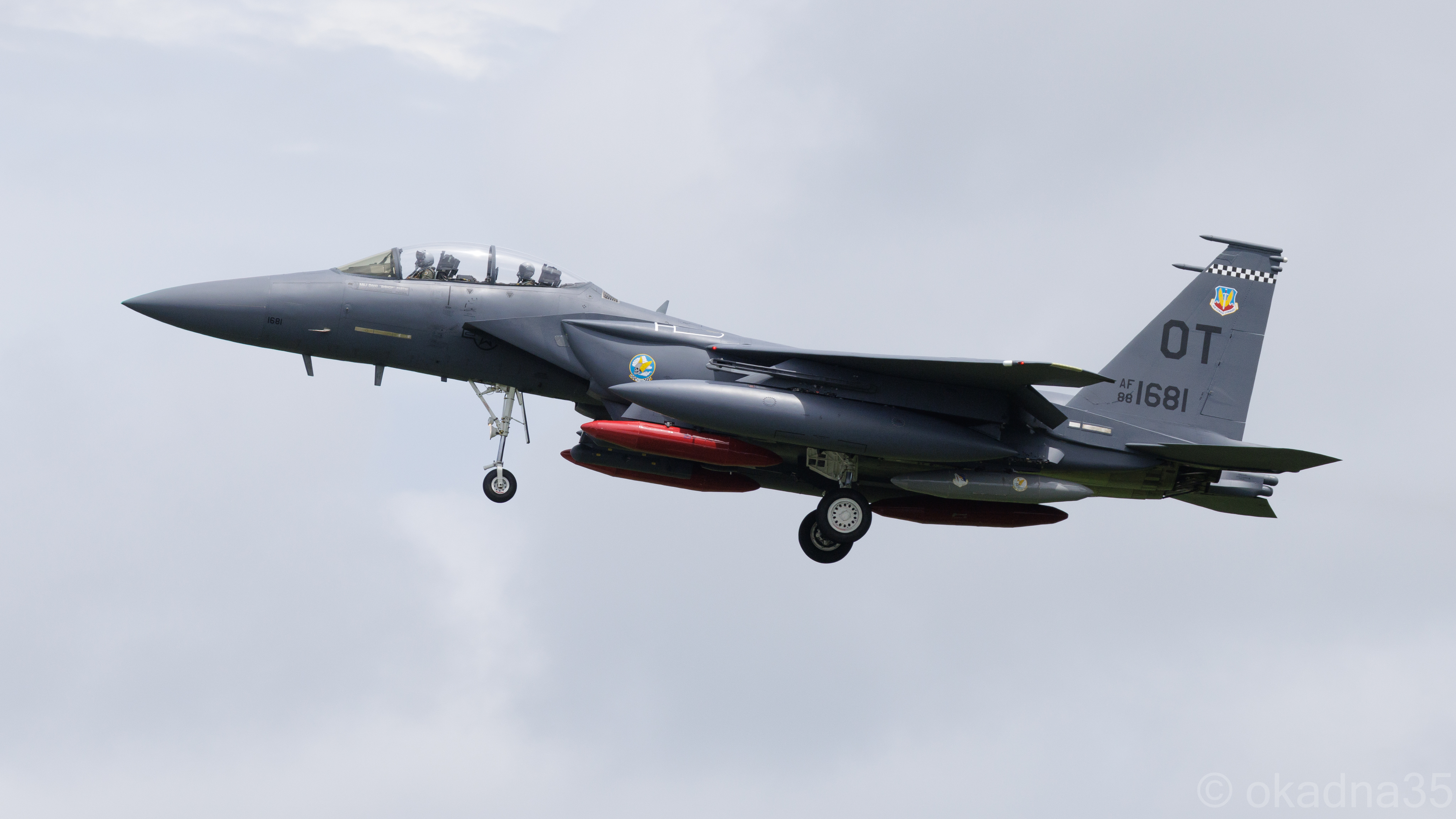104 Kills & Never Shot Down! U.S. To Permanently Deploy Its “EX-Traordinary” Fighter Jets To Guard Taiwan Strait

Before their first permanent overseas deployment, the latest variant of the cutting-edge fighter jet, the F-15EX Eagle II, reached Kadena Air Base on Okinawa, Japan, for a visit. The first operational deployment of the Eagles in the Indo-Pacific has been made as the Taiwan Strait is turning into a potential flashpoint.
The deployment comes at a time when China has surpassed the US in the production rate of fighter jets, challenging the American air superiority. For every US aircraft rolling off an assembly line, China builds 1.2. After building the largest navy in terms of the number of warships, Beijing has turned its eyes skywards now.
The McDonnell Douglas F-15 was introduced in 1976 and has remained unbeatable since. With a remarkable air-to-air kill ratio of 104-0, the aircraft has never been shot down. In the face of an ever-assertive China, the latest variant of F-15 EX Eagle II is a formidable choice to safeguard the Taiwan Strait.
Kadena Air Base is pivotal to the US’s containment strategy for restricting China’s military activities across the Western Pacific Ocean in the event of any contingency. The Air base on Okinawa Island in Japan’s southwestern waters is part of the ‘First Island Chain’.
The airbase is closest to Taiwan, the self-governing island that China has been eyeing to seize by force. The Pentagon has announced plans to replace 48 F-15C/D on Kadena with 36 F-15EX fighter jets. The new variants can carry more air-to-air missiles.
Two F-15EX Eagle II aircraft arrived at Kadena Air Base on July 12 for familiarization training before a permanent fleet of the jet is scheduled to arrive in 2026. The Japanese aircraft spotter posted photos on X showing a pair of F-15EX combat jets, accompanied by an F-15E and an F-16C.

The F-15EX Eagle II is the latest addition to the US Air Force’s fighter jet arsenal. It has been developed to replace the aging F-15C Eagle. The new model, based on the earlier F-15E ‘Strike Eagle’, is a more powerful and capable fighter jet.
The aircraft were deployed under the 85th Test and Evaluation Squadron at Eglin Air Force Base to “conduct integration and familiarisation training with local units” on Okinawa, Kadena’s 18th Wing stated in a news release.
“This short-term visit marks a key milestone in the Department of Defence’s ongoing effort to modernise US airpower in the region and deter against evolving threats,” the release added, noting that it “also prepares Kadena personnel for the arrival and future sustainment of the F-15EX in Spring 2026.”
The USAF has been grappling with a shortage of F-15s due to production delays. The fact that it is one of the oldest aircraft in production today does not help. However, its capabilities make it a highly sought-after fighter jet for deployments to the Pacific.
The most advanced Eagle variant, based on the F-15QA, the Eagle II boasts digital fly-by-wire flight controls and an LAD glass cockpit with a touch-screen interface. It features the APG-82 AESA radar, Joint Helmet-Mounted Cueing System (JHMCS), and Eagle Passive/Active Warning Survivability System (EPAWSS) self-defense suite.
The aircraft pioneers Open Mission System (OMS) software, paving the way for rapid upgrades and capability enhancements, as well as the latest Suite 9.1 software, compatible with upgraded legacy aircraft.
It is faster and can fly longer ranges despite being able to carry increased payloads. Compared to its predecessors, it is claimed to have low operating costs. The Eagle II also has the longest stand-off air-to-air engagement range of any fighter in the USAF’s fleet.
Insufficient F-22 procurement and the increased cost of F-35 development have forced the USAF to extend the service life of the F-15C/D beyond its designed lifespan. Similar infrastructure and training requirements will make F-15 units transition quickly to the F-15EX. The F-15EX is a twin-seater and can accommodate expansion of future crew or missions.
Initially, the USAF had planned to stop the induction of the aircraft in 2001 with the last delivery of F-15Es, and it had ceased production of F-15Cs/Ds in the late 1980s. The production of the F-15s was resumed in the early 2020s after the F-22 and F-35 failed to meet the USAF’s numbers and budget.

Dominating The Air Space
In April 2025, Admiral Samuel Paparo, the new commander of the US Indo-Pacific Command, warned the Senate Armed Services Committee that China was now capable of denying the US air superiority in the first island chain. The First Island Chain is a buffer zone comprising Taiwan, Japan, and the Philippines. Without unfettered air superiority over these waters, the US’s capability to defend its allies from China’s aggression is severely constrained.
The absolute air superiority of the US in the Indo-Pacific is now questionable. After amassing the largest naval force, China is rapidly expanding its aircraft fleet.
It has over 2100 fighters and 200 long-range H-6 bombers. It has deployed over 200 of its 5th-generation J-20 stealth fighter jets, besides unveiling a carrier-based stealth aircraft, the J-35. It is already flight testing two sixth-generation platforms: the J-36 and J-50.
Together with 5th-generation combat aircraft and advanced ‘long-range’ air-to-air missiles, Beijing can prevent the US from achieving air superiority within the key first island chain, a top US Commander has warned.
Heeding the top commander’s warnings, lawmakers across both parties have called for a “crash program” to bolster Pacific air defenses. Proposals include the deployment of more F-35s to Guam, building additional hardened shelters, dispersing aircraft across smaller islands, and enhancing missile defenses, such as the Aegis Ashore systems.
In a March 2024 report for the Center for Strategic and International Studies (CSIS), Seth Jones and Alexander Palmer stated that the US still maintains an advantage in the number of aircraft, as it has a greater number than China’s, particularly in fifth-generation aircraft such as the F-22 and F-35. China operates the third-largest fleet of military aircraft in the world, after only the United States and Russia.
However, China was fast closing the production gap with the US. They point out that China is reportedly producing 100 fifth-generation J-20 fighters annually and tripling the production of other aircraft types, such as the J-10C and J-16, suggesting a high production rate.
Indicating the PLA Air Force’s strategy to innovate, Beijing has been utilizing its legacy fleet in new ways. China has been steadily retiring its fleet of second- and third-generation J-6, J-7, and J-8 fighter aircraft, refurbishing some of them into Unmanned Aerial Vehicles, which “would boost the size of the Chinese air fleet at low cost”. “This could allow China to absorb much greater attrition of aircraft in a Taiwan contingency than its industrial base or pilot training systems could otherwise support,” the CSIS report concurs.
Besides the fighter jets, China is focused on fortifying its air bases, as revealed by a Hudson Institute report titled “Concrete Sky: Air Base Hardening in the Western Pacific”.
According to the report, China is preparing for the possibility of its airfields being targeted in a potential conflict. Since the early 2010s, the PLA has more than doubled its hardened aircraft shelters and unhardened individual aircraft shelters (IASs) at military airfields. This gives China more than 3,000 total aircraft shelters—not including civil or commercial airfields. “This constitutes enough shelters to house and hide the vast majority of China’s combat aircraft. China has also added 20 runways and more than 40 runway-length taxiways, and increased its ramp area nationwide by almost 75 percent,” the report adds.
In comparison, the US expansion and fortification efforts lag far behind. In the same time frame, an examination of airfields within 1,000 nautical miles of the Taiwan Strait, and outside of South Korea, revealed that the US military has added only two HASs and 41 IASs, one runway and one taxiway, and 17 percent more ramp area.
Including ramp area at allied and partner airfields outside Taiwan, combined US, allied, and partner military airfield capacity within 1,000 nautical miles of the Taiwan Strait is roughly one-third of China’s, the report revealed. Without airfields in the Republic of Korea, this ratio drops to one-quarter, and without airfields in the Philippines, it falls further, to 15 percent.
“Overall, this creates an imbalance in which PLA forces would need to fire far fewer ‘shots’ to suppress or destroy US, allied, and partner airfields than the converse,” the report warned.
- Questions and Answers
- Opinion
- Motivational and Inspiring Story
- Technology
- Live and Let live
- Focus
- Geopolitics
- Military-Arms/Equipment
- Sécurité
- Economy
- Beasts of Nations
- Machine Tools-The “Mother Industry”
- Art
- Causes
- Crafts
- Dance
- Drinks
- Film/Movie
- Fitness
- Food
- Jeux
- Gardening
- Health
- Domicile
- Literature
- Music
- Networking
- Autre
- Party
- Religion
- Shopping
- Sports
- Theater
- Health and Wellness
- News
- Culture

